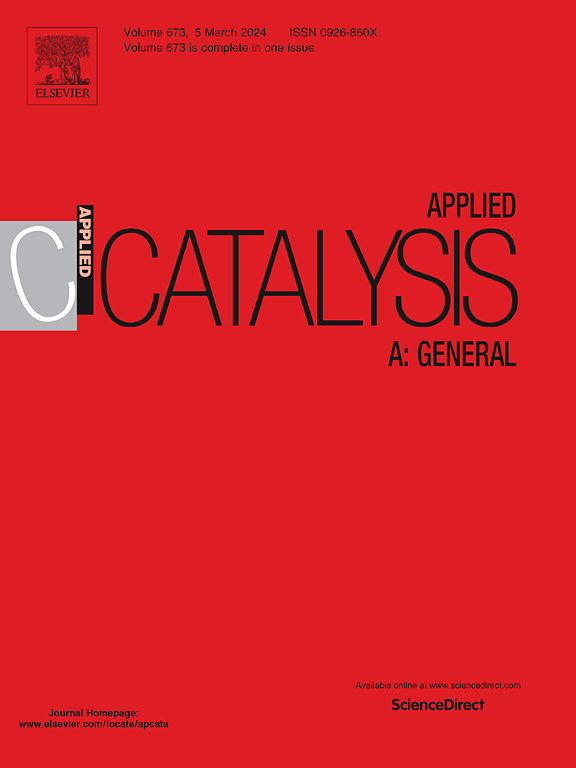Modulating the selective adsorption of biobased diol carbon-oxygen bonds for the synthesis of cyclic carbonates
IF 4.8
2区 化学
Q2 CHEMISTRY, PHYSICAL
引用次数: 0
Abstract
The synthesis of cyclic carbonates via carbon-oxygen bond activation of vicinal-diols and linear carbonates via transesterification is significant, but the reaction mechanism remains unclear. Herein, we synthesized 1,2-butene carbonate (1,2-BC) from 1,2-butanediol (1,2-BDO) and dimethyl carbonate (DMC) as a target reaction and investigated the relationship between different CeO2 crystal effects and acid-base sites. CeO2-rod exhibits more oxygen vacancies (Ce3 +-Ov), generating additional Ce3+ and O2- as Lewis acid and base sites, respectively, enhancing the activation of C-O and O-H bonds. CeO2-R exhibited high activity, achieving a space-time yield of up to 500 g1,2-BC·h−1·gcat−1 during 200 h long-term operation. Difficulty in adsorption of the active conformation due to the presence of competing adsorption, in situ DRIFTS revealed that the bridging butoxy-Ov of 1,2-BDO and the cis-cis monodentate adsorption conformation of DMC play a decisive role in the reaction. The presence of key intermediates that are difficult to capture was confirmed for the first time. Molecular dynamics simulations justify the proposed theory of dehydrocyclization of the intermediate hydroxy butylmethyl carbonate to 1,2-BC. The good generalizability of vicinal-diol substrate provides a reference and inspiration for synthesizing cyclic carbonates.
调节生物基二醇碳氧键的选择性吸附合成环状碳酸盐
邻二醇碳氧键活化法合成环状碳酸盐和酯交换法合成线性碳酸盐具有重要意义,但其反应机理尚不清楚。本文以1,2-丁二醇(1,2- bdo)和碳酸二甲酯(DMC)为目标反应合成了1,2-丁烯碳酸(1,2- bc),并研究了不同的CeO2晶体效应与酸碱位的关系。ceo2 -棒表现出更多的氧空位(Ce3 +- ov),分别生成额外的Ce3+和O2-作为Lewis酸和碱位点,增强了C-O和O-H键的活化。CeO2-R表现出较高的活性,在200 h的长期运行中,时空产率高达500 g1,2-BC·h−1·gcat−1。由于竞争吸附的存在,活性构象难以吸附,原位漂移表明1,2- bdo的桥接butoxy-Ov和DMC的顺-顺单齿吸附构象在反应中起决定性作用。首次确认了难以捕获的关键中间体的存在。分子动力学模拟证明了中间羟基碳酸丁基甲基脱氢到1,2- bc的理论。邻二醇底物具有良好的通用性,为环状碳酸盐的合成提供了参考和启示。
本文章由计算机程序翻译,如有差异,请以英文原文为准。
求助全文
约1分钟内获得全文
求助全文
来源期刊

Applied Catalysis A: General
化学-环境科学
CiteScore
9.00
自引率
5.50%
发文量
415
审稿时长
24 days
期刊介绍:
Applied Catalysis A: General publishes original papers on all aspects of catalysis of basic and practical interest to chemical scientists in both industrial and academic fields, with an emphasis onnew understanding of catalysts and catalytic reactions, new catalytic materials, new techniques, and new processes, especially those that have potential practical implications.
Papers that report results of a thorough study or optimization of systems or processes that are well understood, widely studied, or minor variations of known ones are discouraged. Authors should include statements in a separate section "Justification for Publication" of how the manuscript fits the scope of the journal in the cover letter to the editors. Submissions without such justification will be rejected without review.
 求助内容:
求助内容: 应助结果提醒方式:
应助结果提醒方式:


